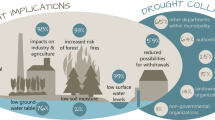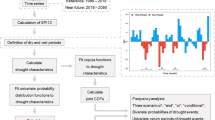Abstract
A growing body of research indicates that opinions about long-term climate change and other natural resource issues can be significantly affected by current weather conditions (e.g., outside air temperature) and other highly contingent environmental cues. Although increased severity and frequency of droughts is regarded as a likely consequence of anthropogenic climate change, little previous research has attempted to relate the experience of drought with public attitudes about water supply or water-related climate change issues. For this study, a large set (n = 3,163) of public survey data collected across nine states of the southern United States was spatio-temporally linked with records of short-term (~12 weeks) and long-term (~5 years) drought condition at the level of each respondent’s zip code. Multivariate ordinal logistic regression models that included numerous other independent variables (environmental ideology, age, gender, education, community size, residency duration, and local annual precipitation) indicated highly significant interactions with long-term drought condition, but showed no significant effect from short-term drought condition. Conversely, attitudes about water-related climate change showed highly significant interactions with short-term drought, with weaker to no effects from long-term drought. While the finding of significant effects from short-term drought condition on opinions about future drought is broadly consistent with previous public opinion research on climate change, the finding of water supply attitudes being more responsive to longer term drought condition is, to our knowledge, a novel result. This study more generally demonstrates the methodological feasibility and applied importance of accounting for local drought condition when public opinion information is used to evaluate outreach programs for water conservation and climate change.
Similar content being viewed by others
Explore related subjects
Discover the latest articles and news from researchers in related subjects, suggested using machine learning.References
Adams DC, Allen D, Borisova T, Boellstorff DE, Smolen MD (2013) The influence of water attitudes, perceptions, and learning preferences on water-conserving actions. Nat Sci Educ 42:114–122
Akerlof K, Maibach EW, Fitzgerald D, Cedono AY, Neuman A (2013) Do people “personally experience” global warming, and if so how, and does it matter? Glob Environ Chang 21:81–91
Bjorkland R, Pringle CM (2001) Educating our communities and ourselves about conservation of aquatic resources through environmental outreach. Bioscience 51:279–282
Borisova T, Useche P, Smolen MD, Boellstorff DE, Sochacka NW, Calabria J, Adams DC, Mahler RL, Evans JM (2013) Differences in opinions about surface water quality issues in the southern United States: implications for watershed planning process. Nat Sci Educ 42:104–113
Casagrande DG, Hope D, Farley-Metzger E, Cook W, Yabiku S, Redman C (2007) Problem and opportunity: integrating anthropology, ecology, and policy through adaptive experimentation in the urban U.S. Southwest. Hum Organ 66:125–139
Cohen S, Neilsen D, Smith S, Neale T, Taylor B, Barton M, Merritt W, Alila Y, Shepherd P, Mcneill R, Tansey J, Carmichael J, Langsdale S (2006) Learning with local help: expanding the dialogue on climate change and water management in the Okanagan Region, British Columbia, Canada. Clim Chang 75:331–358
Daly C, Taylor G (2000) United States average annual precipitation, 1961–1990. http://nationalatlas.gov/mld/prism0p.html. Accessed 5 Feb 2014
Day JW, Boesch DF, Clairain EJ, Kemp GP, Laska SB, Mitsch WJ, Orth K, Mashriqui H, Reed DJ, Shabman L, Simenstad CA, Streever BJ, Twilley RR, Watson CC, Wells JT, Whigham DF (2007) Restoration of the Mississippi Delta: lessons from Hurricanes Katrina and Rita. Science 315:1679–1684
Delorme DE, Hagen SC, Stout IJ (2003) Consumers’ perspectives on water issues: direction for educational campaigns. J Environ Educ 34:28–35
Dietz T, Kalof L, Stern PC (2002) Gender, values, and environmentalism. Soc Sci Q 83:353–364
Diggs DM (1991) Drought experience and perception of climatic change among Great Plains farmers. Great Plains Res: J Nat Soc Sci :114–132. http://digitalcommons.unl.edu/cgi/viewcontent.cgi?article=1000&context=greatplainsresearch. Accessed 26 Dec 2014
Dillman D (2000) Mail and internet surveys. Wiley, New York
Dong X, Baike X, Kennedy A, Feng Z, Entin JK, Houser PR, Schiffer RA, L’Ecuyer T, Solson WS, Hsu K, Liu WT, Lin B, Deng Y, Jiang T (2011) Investigation of the 2006 drought and 2007 flood extremes at the Southern Great Plains through an integrative analysis of observations. J Geophys Res-Atmos [Online] 116: Article D03204. http://onlinelibrary.wiley.com/doi/10.1029/2010JD014776/pdf. Accessed 27 Dec 2014
Dow K (2010) News coverage of drought impacts and vulnerability in the U.S. Carolinas, 1998–2007. Nat Hazards 54:497–518
Edwards ML, Dillman DA, Smyth JD (2014) An experimental test of the effects of survey sponsorship on internet and mail survey response. Public Opin Q 78:734–750
ESRI (2011) ArcGIS Desktop: Release 10. Environmental Systems Research Institute, Redlands
Feldman DL (2009) Preventing the repetition: or, what Los Angeles’ experience in water management can teach Atlanta about urban water disputes. Water Resour Res 45, W04422. doi:10.1029/2008WR007605
Gleick PH, Cooley H, Katz D, Lee E, Morrison J, Palaniappan M, Samulon A, Wolff GH (2006) The world’s water 2006–2007: the biennial report on freshwater resources. Island Press, Washington
Gueguen N (2012) Dead indoor plants strengthen belief in global warming. J Environ Psychol 32:173–177
Hamilton LC, Colocousis CR, Duncan CM (2010) Place effects on environmental view. Rural Sociol 75:326–347
Harrell FE (2001) Regression modeling strategies with applications to linear models, logistic regression, and survival analysis. Springer, New York
Hastie T, Tibshirani R, Friedman J (2009) The elements of statistical learning. Springer, New York
Heath Y, Gifford R (2006) Free-market ideology and environmental degradation: the case of belief in global climate change. Environ Behav 38:48–71
Heim RR (2002) A review of twentieth-century drought indices used in the United States. Bull Am Meteorol Soc 83:1149–1165
Hightower M, Pierce SA (2008) The energy challenge. Nature 452:285–286
Howe PD, Leiserowitz A (2013) Who remembers a hot summer or a cold winter? The asymmetric effect of beliefs about global warming on perceptions of local climate conditions in the U.S. Glob Environ Chang 23:1488–1500
Jackson-Smith DB, McEvoy JP (2011) Assessing the long-term impacts of water quality outreach and education efforts on agricultural landowners. J Agric Educ Ext 17:341–353
Jensen R (1996) Why droughts plague Texas: dry spells have always been part of Texas and will likely continue. Text Water Res 22:1–13
Joireman J, Truelove HB, Duell B (2010) Effects of outdoor temperature, heat primes and anchoring on belief in global warming. J Environ Psychol 30:358–367
Jorgensen B, Graymore M, O'Toole K (2009) Household water use behavior: an integrated model. J Environ Manage 91:227–236
Knutson CL (2008) The role of water conservation in drought planning. J Soil Water Conserv 63:154A–160A
Leiserowitz AA (2005) American risk perceptions: is climate change dangerous? Risk Anal 25:1433–1442
Li Y, Johnson EJ, Zaval L (2011) Local warming: daily temperature change influences belief in global warming. Psychol Sci 22:454–459
Lockett L, Montague T, McKenney C (2002) Assessing public opinion on water conservation and water conserving landscapes in the semi-arid southwestern United States. HortTechnology 12:392–396
Lorenzoni I, Pidgeon NF (2006) Public views on climate change: European and USA perspectives. Clim Chang 77:73–95
Mahler RL, Simmons R, Sorensen F, Minder JR (2004) Priority water issues in the Pacific Northwest. J Extension [Online] 42: Article SRIB3. http://www.joe.org/joe/2004october/rb3.php. Accessed 5 Feb 2014
Mahler RL, Shafii B, Hollenhorst S, Anderson BJ (2008) Public perceptions on the ideal balance between natural resource protection and use in the Western USA. J Extension [Online] 46: Article 1RIB2. http://www.joe.org/joe/2008february/rb2p.php. Accessed 30 Dec 2014
Mahler RL, Smolen MD, Borisova T, Boellstorff DE, Adams DC, Sochacka NW (2013) The National Water Survey needs assessment program. Nat Sci Educ 42:98–103
Mansur ET, Olmstead SM (2012) The value of scarce water: measuring the inefficiency of municipal regulations. J Urban Econ 71:332–346
Manuel J (2008) Drought in the southeast: lessons for water management. Environ Health Perspect 116:A168–A171
Mohai P, Twight BW (1987) Age and environmentalism: an elaboration of the Buttell model using national survey evidence. Soc Sci Q 68:798–815
NDMC, USDA, and NOAA (2012) U.S. Drought Monitor. http://droughtmonitor.unl.edu/monitor.html. Accessed 5 Feb 2014
Palutikof JP, Agnew MD, Hoar MR (2004) Public perceptions of unusually warm weather in the UK: impacts, responses, and adaptations. Clim Res 26:43–59
Raphael B, Taylor M, Stevens G, Barr M, Gorringe M, Agho K (2009) Factors associated with population risk perceptions of continuing drought in Australia. Aust J Rural Health 27:330–337
Rosenzweig C, Major DC, Demong K, Stanton C, Horton R, Stults M (2007) Managing climate change risks in New York City’s water system: assessment and adaptation planning. Mitig Adapt Strateg Glob Chang 12:1391–1409
Routhe AS, Jones RE, Feldman DL (2005) Using theory to understand public support for collective actions that impact the environment: alleviating water supply problems in a nonarid biome. Soc Sci Q 86:874–897
Safi AS, Smith WJ, Liu Z (2012) Rural Nevada and climate change: vulnerability, beliefs, and risk perception. Risk Anal 32:1041–1059
Sall J, Creighton L, Lehman A (2007) JMP start statistics: a guide to statistics and data analysis using JMP. SAS Institute, Cary
Semenza JC, Hall DE, Wilson DJ, Bontempo BD, Sailor DJ, George LA (2008) Public perception of climate change: voluntary mitigation and barriers to behavior change. Am J Prev Med 35:479–487
Shepard R (2002) Evaluating extension-based water resource outreach programs: Are we meeting the challenge? Journal of Extension [Online] 40: Article 1FEA3. http://www.joe.org/joe/2002february/a3.html. Accessed 5 Feb 2014
Shepherd M, Mote T, Dowd J, Roden M, Knox P, McCutcheon SC, Nelson SE (2011) An overview of synoptic and mesoscale factors contributing to the disastrous Atlanta flood of 2009. Bull Am Meteorol Soc 92:861–870
Trumbo CW, Markee NL, O’Keefe G, Park E (1999) Antecedent precipitation as a methodological concern in attitude surveys on water conservation. Water Resour Res 35:1269–1273
Vaske JJ, Donnelly MP, Williams DR, Jonker S (2001) Demographic influences on environmental value orientations and normative beliefs about national forest management. Soc Nat Resour 14:761–776
Wang H, Fu R, Kumar A, Li W (2010) Intensification of summer rainfall variability in the southeastern United States during recent decades. J Hydrometeorol 11:1007–1018
Weber EU, Stern PC (2011) Public understanding of climate change in the United States. Am Psychol 66:315–328
Woudenberg DL, Wilhite DA, Hayes M (2008) Perception of drought hazard and its sociological impact in south-central Nebraska. Great Plains Res 18:93–102
Zelezny LC, Chua PP, Aldrich C (2000) New ways of thinking about environmentalism: elaborating on gender differences in environmentalism. J Soc Issues 56:443–457
Acknowledgments
Research for this paper was developed through the authors’ participation in the United States Department of Agriculture’s Southern Region Water Policy and Economics team. We sincerely thank K. Loeffelman for her management and assistance with the National Water Survey dataset. We also sincerely thank C. Paulsen from the National Drought Mitigation Center for sharing background references and boundary shapefile used in the U.S. Drought Monitor datasets. Invaluable feedback through the analysis and manuscript preparation process was provided by J. Reeves and K. Love-Myers at the University of Georgia’s Statistical Consulting Center. Insightful comments from three anonymous reviewers provided the basis for substantial improvements to the final manuscript.
Author information
Authors and Affiliations
Corresponding author
Electronic supplementary material
Below is the link to the electronic supplementary material.
Online Resource 1
GIS workflow for developing drought condition scores. (DOC 70 kb)
Online Resource 2
Dates of state surveys and associated dates of U.S. Drought Monitor shapefiles used to calculate drought condition scores. (DOC 40 kb)
Online Resource 3
Long-term and short-term drought condition scores by Southern Region survey zip code. (DOC 555 kb)
Online Resource 4
Mean annual precipitation for states included in the Southern Region survey (adapted from Daly and Taylor 2000). (DOC 173 kb)
Online Resource 5
Scaled image provided to respondents for “Environmental ideology” question. (DOC 117 kb)
Online Resource 6
Independent socio-demographic variables from survey instrument (DOC 47 kb)
Rights and permissions
About this article
Cite this article
Evans, J.M., Calabria, J., Borisova, T. et al. Effects of local drought condition on public opinions about water supply and future climate change. Climatic Change 132, 193–207 (2015). https://doi.org/10.1007/s10584-015-1425-z
Received:
Accepted:
Published:
Issue Date:
DOI: https://doi.org/10.1007/s10584-015-1425-z




